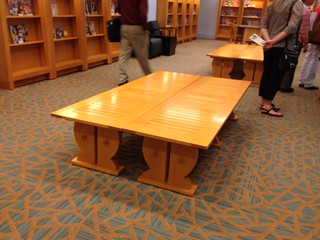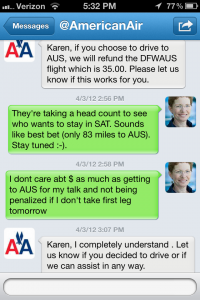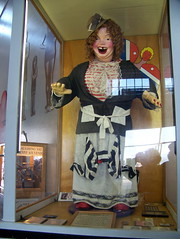I’m going to focus on some highlights, rather than rehashing the entire Library Journal Design Institute, but overall it was a timely, highly worthwhile event, a solid mix of panel sessions and interactive problem-solving sessions. Most of the attendees were from public libraries, but there were a few academics, and the ones I spoke with were in agreement that academic librarians can learn a lot from studying public library design (not just facilities, either, but services as well).
The informal theme of this institute — I think I heard LJ has done about 20 of these? — is, in Joseph Sanchez’s terms, “library as question mark.” Sanchez, from the Auraria Library at the University of Colorado, was on an opening panel where he and Matt Hamilton from Anythink Libraries talked about the impact of changes in the reading ecology on how library space is used, with a lot of conversation about users creating digital content. Traci Lesneski from MS&R talked about the library as extrovert: more transparent, more visible — a point that resonated as I thought about our library becoming more proactively welcoming.
Nevertheless, for all the talk about content creation, library gardens, gaming, and so on, implicit in all the sessions that day was the idea that when users walk into a library, they want to see people and products (versus wandering into an empty space –Â I saw this at a fairly new university library where my first thought was that the first-floor lobby was a missed opportunity).
Those products will probably include books, but can also include DVDs and other media. In some cases, the users themselves may be the attraction, on display as they create, browse, and read (not unlike watching the pizza maker twirl his dough). And build in a visible location for a helpful human presence — call it a librarian or library worker, but I hear the word “concierge” a lot these days (waving at West Hollywood!), and think that’s a good fit for that role.
There were tours the previous day which my travel schedule didn’t let me attend, but I did get the tour of Denver Public Library, which for me had several ah-hah moments. As one librarian, a facility manager, observed, I got the tour I needed. It’s a midcentury building about the same age as my library, and it had a renovation and expansion in 1990 led by Michael Graves. So their challenge was to preserve an iconic look and feel while bringing the library into the technology era. I don’t have those challenges per se, but renovating a pre-technology building with “good bones” is certainly relevant.
Plus I saw Michael Graves benches scattered about DPL, and thought, Perfect. Benches. Which leads (rather loosely, like a dog galloping ahead of its owner) to a point made at the Institute: the project lead for a library design need to be outgoing and friendly, but also firm. That describes me to a tee on my best days. (I will refrain from commenting on what I’m like on my worst days.)
The leader must also have strong and well-communicated ideas and opinions–like, those benches are a great fit — but be flexible. One strong idea I had early on (courtesy of Linda Demmers, a bit more on her below) is that our library would absolutely need a thorough facility inspection before any other design activity moved forward (with the exception of the computer classroom), and that’s wrapping up as I write this. (By the way, who knew there were so many ways to use asbestos?).
I was right, and sticking to my guns was the right thing to do. It doesn’t mean I’m always right, or that, when I know I’m right, I always stick to my guns, but when I’ve got the Greek Chorus of Experienced Library Administrators chanting “You’ll be sorry if you don’t do that,” I do try to do the right thing.
I realized as well that I am beginning to synthesize and organize my ad-hoc education in library facilities. During one interactive session, people discussed how to guide users through a library. “Power paths,” I peeped up. I had seen an example of these in a public library when Linda Demmers came to our library for a day-long consulting visit and did a slideshow. Think of how Ikea pulls you through a store.
There are many ways to design a path, and they don’t have to be underfoot, either — think of that part of O’Hare where you are guided through a connector by undulating lights. The group liked the power-path idea, as did the architects (for whom it wasn’t a new concept, as became apparent when they pulled out their drawing, which sure enough featured a power path).
I’m also getting to the point that I feel I at least know the major vendors in the field and can pick out an Agati easy chair at 20 paces, plus figure out whether that media desk is from Steelcase or KI. But even more significantly, I’m feeling the landscape of this knowledge area and beginning to understand where my rather significant gaps are — for example, sustainability.
Most of all I realized I’m catching the facility bug. There was a time when a renovation or new-building project only interested me in the most abstract, utilitarian manner possible. I have even felt relief that my career had not overlapped with anything more involved than upgrading computers and so forth. Now I’m genuinely excited to be on this journey; it is a big part of what puts spring in my step as I walk into the library every day.
Anyway, the following is just a pastiche of ideas gleaned from the day (sans synthesis, but with a bonus digression or two). LJ also encouraged everyone to see the LandMark Libraries discussed in their May 15 issue, and to watch for the July 1 issue for academic libraries.
- Content creation is more than just about digital experience — it can include visual, applied, and performance arts; crafts; library gardens; etc.
- Using local materials roots the building in the community
- IT costs are hard to quantify because you always want more
- Under-carpet wiring has improved a lot (aside: I remember dealing with an under-carpet wiring issue over a decade ago that was originally presented as an electricity shortage; staff were actually taking turns using computers because there “wasn’t enough electricity.” My dad was an electrician, among other things, and that popped my B.S. flag. Sure enough, there was plenty of electricity, once it had wiring to flow through).
- Openness and flexibility can interfere with comfort. Broad open spaces don’t make us feel comfortable, and don’t make us want to linger. Look at creating rooms within rooms. (We have these spaces under stairwells I’ve wanted to equip with easy chairs, small rugs, and hanging lamps. Maybe this will help me find the time to do this.)
- Lighting: libraries tend to use the same lighting everywhere in public areas. Focus more on task lighting — it’s more flexible. The brightest light is not the light you always need or want.
- A good design must be founded on sustainable principles (this is one of the Landmark Library guidelines).
- Develop a strong statement that establishes guiding principles for the project. People may come and go from all parts of the project; the project needs coherent, continuous coherent direction.
- Yes, you need good signage: big, simple, and clear.
- Question assumptions.
- Get big results from small decisions.
- Bring in the light (walking through the Denver airport where there was a display on city architecture, I learned that’s called “daylighting”).
- Think privacy, but think collaboration.
- Rediscover quiet (amen on that one: one of my summer projects is to visibly zone the library into noise levels).
- Respect history.
- In comparing construction costs, be sure you’re comparing apples to apples.
- Keep your facilities people involved.
- There is no greener building than the building that already exists.
- Don’t build a 15-year building; don’t make them so cheap that they can’t last a long time.
- There is no value in value engineering. “Value engineering” only prolongs the problem ; it will end up costing you more. N.b. those comments intrigued me even as they resonated. Worth hunting down relevant articles.
- Hiring an architect with a lot of library experience is a cost-cutting exercise; it’s incredibly important to the success of this project.
- Design spaces that can be used for a variety of purposes and at different times.
- Look at your existing assets and find ways to leverage them better.
- Drywall on masonry is putting 15-year material on top of 100-year material.
- Sustainability is ultimately about using less.
- A great location makes it much easier to get people in the library.
- Be buyer-aware about the people who are going to use your money.
- Integrated project delivery is the newest PM approach; the whole team is put together at the beginning. Instead of silos, the team is more like a studio.
- Watch out for project soft costs: construction, land, shelving, furniture, technology, infrastructure for wiring for phones, computers, etc; adding more books, collection development, research to start the project, site surveys, geotech consultants, lawyers for reviewing contracts,moving costs (especially if doing the project in phases), developing a phasing plan.
- Costing sustainability: don’t guess, bring an energy analyst on board to work with the design team to evaluate cost decisions.
- LEED isn’t the be-all end-all of sustainability, and can be an expensive, difficult direction. You can design a sustainable library you’re proud of even if you don’t get a plaque. (That said, I bet a workshop or class about LEED would be a great introduction to sustainability in construction.)
- Nobody said this, I just thought it: “iconic” seems to be a synonym for “expensive and difficult to renovate.”
So yes, it was worth it. As with most activities, networking with others was a major part of the experience. There’s a lot of wisdom in LibraryLand, and some of it is translated into building and updating enduring and beloved landmarks.
Finally, this is an area where I want to grow. As noted on Facebook and Twitter, at the closing reception I asked a library director, how can I learn more about library building projects? There’s so much to know! Him: um… by reading books? OH RIGHT, BOOKS. I’ve found two to start with (and I visited Donald Barclay’s library and he knows whereof he speaks); recommendations welcome.














